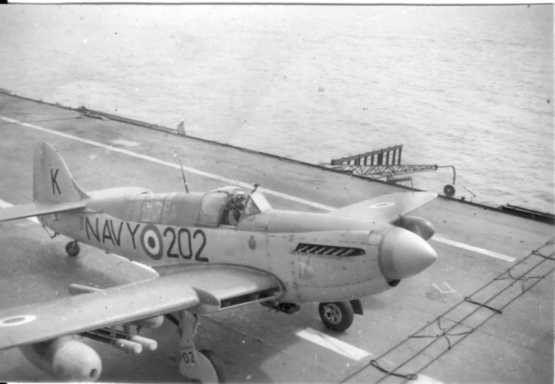- Author
- van Gelder, Commander John RAN (Rtd)
- Subjects
- Biographies and personal histories, Naval Aviation, Post WWII
- Tags
-
- RAN Ships
- 817 Squadron, HMAS Sydney III
- Publication
- June 2004 edition of the Naval Historical Review (all rights reserved)
IT IS DOUBTFUL if there is anything in the world more complex than the human mind. In our passage through life we are all subjected to experiences which have an impact on our lives, and indeed, may have a profound influence on our future courses of action. I do not think it is unique that certain events which have had a strong impression on our minds can recur in our thoughts at reasonably frequent intervals.
Not long ago a nephew of mine, whom I had not seen for some years, said to me quite unexpectedly ‘What were your most exciting moments whilst you were flying in the Navy?’ The question took me aback and I think I mumbled something about it all being exciting.
Reflecting on the question later I knew exactly how I should have answered. In the Fleet Air Arm there would not be any pilot who could say that they had not experienced some hairy moments and brief periods of high drama whilst flying. But human nature being what it is these moments are generally relegated to the back of the mind as unpleasant thoughts. Well, hopefully anyway, and my answer to the question is not related to any frightening or dangerous event.
I am not sure I have the literary skill to answer the question adequately. However, the event which has had a profound effect on me and the vision of which comes to my mind so frequently occurred many years ago in 1955. At the time I was a pilot of 817 Squadron RAN, equipped with Fairey Firefly aircraft embarked in HMAS Sydney.

On 12th March 1955 I was programmed for an early take off. Incidentally, a pilot’s Flying Log Book is a wondrous thing. Do you know what you were doing at a precise time nearly fifty years ago?
From memory on the morning of the 12th the ship was in a position some twenty or thirty miles east of Twofold Bay off the south coast of New South Wales. Having had an early breakfast followed by the usual pre-flight briefing my observer, Joe Tidey, and I emerged from the island onto the flight deck. The vision that greeted us could not be described as a pretty sight. Although not pitch black it was very dark, with a complete overcast of deep stratus cloud with a cloud base of perhaps 1200 feet.
After external pre-flight checks we manned our Firefly, serial No. WB 507, Squadron side No. 202, started the engine, carried out the usual engine and system checks and were directed from the deck park to the catapult. It was from the time of arrival on the catapult that the vision of the scene becomes so vivid in my memory.
Once an aircraft arrives on the catapult, various actions both outside and inside the aircraft happen very quickly indeed. A wire strop is attached to two hooks on the fuselage of the aircraft and engaged with the catapult shuttle whilst a tang on the aircraft at the rear of the fuselage below the rudder is attached to the hold back strop and secured with a steel shear ring. Meanwhile inside the cockpit constant checks are made on the aircraft systems, particularly engine temperatures and pressures, propeller pitch setting, trim settings, locking the tailwheel, and lowering the flaps to take off position. All these actions take place in a period of perhaps thirty seconds.
It was during this short time period that the visual scene and probably the emotional atmosphere had such a marked impact on my memory. My Log Book records the take off time as 0550. As I raised my head from looking at the red glow of the instruments inside the cockpit my vision automatically adjusted itself to distant vision as I looked through the forward windscreen. It was still quite dark due to the almost complete cloud cover but on the distant horizon to the east the cloud bank had broken to reveal a thin sliver of light. At least it would not be an instrument take off. The ship was on a roughly easterly heading with about ten knots of wind and a long low swell giving a slow but noticeable pitching motion.




